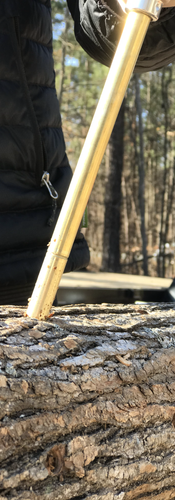What is Mushroom Log Inoculation?
- Kara Thornton
- Aug 5, 2021
- 3 min read
Ever heard of this practice? It seems to be taking the world by storm right now as mushroom farms emerge and individuals start cultivating their own mushrooms for the table!
TLDR Here's the skinny:
Mushroom Log Inoculation is where you 'plant' (inoculate) edible mushroom species 'seeds' (spores) in a log & with enough shade, rain, and ~good vibes~ your log will produce mushroom fruitings to harvest within a few months or even years.
Now for the meaty info:
In March of 2020 just before the pandemic shut everything down, we were lucky enough to visit a local mushroom farm for a log inoculation class. Here we toured the farm and learned about the inoculation process.
Similar to planting a crop, we needed the right 'soil' and 'seeds'. In the case of mushrooms, this meant we needed the right substrate and spores.
The substrate is a material that mushroom mycelium can grow and establish itself in. Spores are the tiny, reproductive cells that allow fungus to replicate and grow.
The substrate of the species we inoculated (Blue Oyster, Lion's Mane, & Shiitake) is dead hardwood. The farm had collected the spores of each of these mushrooms into mixtures of the specific spores & sanitized sawdust.
The farm had pre-drilled a series of holes in hard wood logs that were about 3.5' tall and 3"-6" in diameter. These logs had been cut shortly after the trees had died; the sooner you inoculate the log, the better because you want to be sure to avoid any limbs with rot. You can find a list of hardwood tree species that have proven to work best here on the Asheville Fungi website of North Carolina.
Next we picked our species of mushrooms and used a tool called an inoculation plunger to collect the pre-made mixture of sawdust & spores to then inject it into each hole of the log.
Pro Tip: If you're a beginner, the easiest method is to purchase pre-made mushroom grow plugs from a local mushroom farm, farmers market, or even online shop.
To seal the sawdust & spore mixture inside the holes, the farm provided us hot wax and a small brush to cover each opening.
Interested in trying it for yourself?
Here are the summarized steps to inoculating your very own mushroom logs:
Collect fresh hardwood logs, 3'-4' Tall and 3"-6" in diameter
Drill holes (drill bit size & depth depending on your inoculation plunger -or- your pre-made grow plugs) columns spaced 6" apart, rows 3"-4" apart, and always at least 2" from either end.
Cover your holes with a hot wax as sealant
Store your inoculated logs in a shady area with full exposure to rain. If you have multiple, stack the logs on top of each other in a criss cross pattern to allow ample surface area to be exposed. Logs have been known to do better when they're stored just off the ground; pallets are a great way to achieve this.
Optional steps:
Soak your inoculated log in water before storing them (this step is only necessary if your log you're using is over 10 days old). Additionally if you experience a dry spell, you can water your log. For this I would suggest distilled water or collected rain water if available.

A very important part of this process is PATIENCE. For our four logs it took us 17 months to see any action. Here's what I think contributed to the slow progress:
- We had to move the logs around a couple times after a few months. We did some landscaping and ended up moving them to under a different tree. Additionally, we did not stack our logs but instead leaned them against a tree which caused them to have direct contact with the ground which can invite pests and other, less desirable fungi.
- After we'd moved the logs our neighbors had multiple trees cut down which caused a flood of sunlight on the logs which took us weeks to notice. Once we did we moved them once again, further in the shade.
- We did not soak our logs or give them any extra water. Though we had a relatively wet year in 2020, the Spring of 2021 was very dry which may have contributed to a lack of fruiting.
- We heard stories of squirrels and raccoons getting into other people's logs they'd inoculated that day, which of course can hinder fruiting production.
- Though we didn't see fruitings the first year, it's important to consider the season of each of these mushrooms. For example the blue oysters are now fruiting from our logs (YAY!) but if we're not discouraged that we haven't seen lions mane, as that species tends to fruit closer to the autumn season.
Sources:
.png)






















Comments